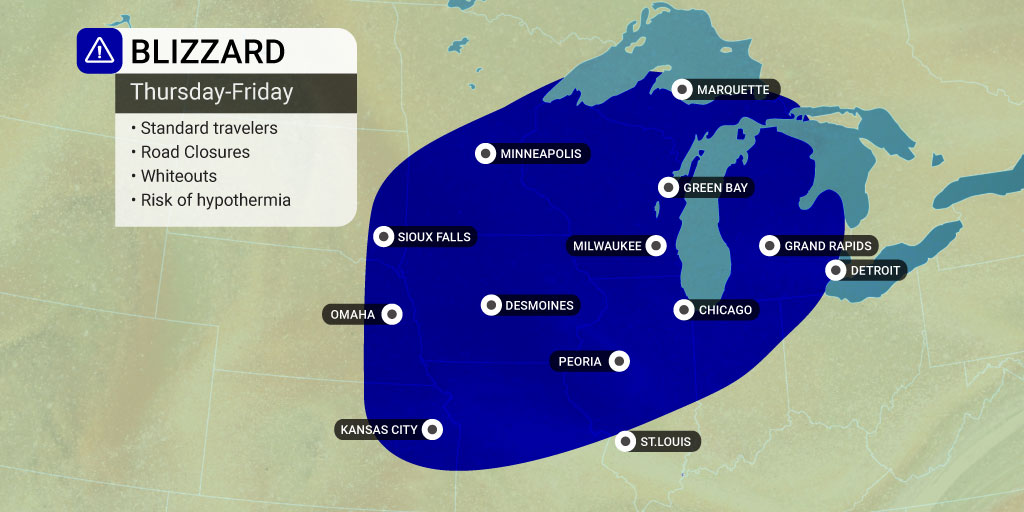
It’s the first week of winter in many areas of the world. In the United States, it seems like Mother Nature wants people to know it. This holiday week, people throughout the country have learned how quickly the weather can force them to rethink travel plans. Below-freezing temperatures hit the U.S. in many Northwest and Central regions on Tuesday and Wednesday (December 20 and 21). Meteorologists expect rapidly changing temperatures and weather conditions not only until the end of the week but also through the weekend.
Read on to learn more…
The Arrival of a Bomb Cyclone
Read More »Approximately 50 million Americans received the alert with severe wind chill warnings, equal in pressure to a Category 2 hurricane, reaching as far as the Great Lakes and even Maryland. Meteorologists and other weather experts have referred to it as an historic event with the temps reaching the coldest levels felt in four decades.
Below-Zero Temps
Some areas of the northern states can expect wind chills of -35 to -55 degrees Fahrenheit starting Tuesday through the end of the week. These temps can cause frostbite (freeze skin) within approximately 5 to 10 minutes. They can also lead to rapid hypothermia (low body temperature). These temperature changes won’t merely cause the skin reddening and pain commonly seen with frostnip. Instead, anyone exposed can experience tissue necrosis. Experts warn that these temps can even damage the eyes by causing ice crystals to form in cells.

Known as a polar plunge, the changes happen as a storm from the West moves East with over 80% of the U.S. experiencing some sort of severe temperature drop. States under the highest level of watch include Illinois, Minnesota, Montana, North Dakota, South Dakota and Wyoming. At least some portions of Wyoming could possibly experience -70 degrees Fahrenheit wind chill on Wednesday night. People in the Midwest have been warned of “life-threatening” weather conditions and to seek warming centers immediately during power outages.
Rapidly Changing Temps
The coldest weather isn’t the only frightening factor this week. People in impacted zones need to watch for bomb cyclone rapid temperature changes. Someone enjoying an estimated 60-degrees Fahrenheit in New York City on Friday should expect a rapid drop to potentially as low as 24-degrees Fahrenheit by Saturday.
Southern states, such as Florida and Texas, are also expected to experience below-freezing and rapidly-changing temps starting in the middle of the week. The wind chill might cause pipe bursting and infrastructure problems, as these types of changes cause rapid switches from rain to snow and ice. They can also make pavements and roadways slippery and dangerous and lead to unexpected cold exposure and frostbite events for people who aren’t used to dealing with cold weather.
A White Christmas
Although many people hope for a white Christmas or start of the winter season, they might consider this week’s weather a bit too much. Starting on Wednesday, December 21, some portions of the Midwest can expect high levels of snow that won’t stop dropping to some degree until late Christmas day.
Beyond these conditions, residents can expect blizzard conditions for three hours or longer with wind gusts of an estimated 40 to 50 mph and quarter-mile or less visibility. Some forecasters estimate that Chicago, for example, might experience up to 8 inches of snow and possible 55 mph gusts from a blizzard between early Thursday and late Friday.
Holiday Travel Precautions
Experts agree that staying in place is a good idea if travel isn’t absolutely necessary, especially in light of the current tri-demic of COVID, RSV and influenza that’s also hitting the country hard. Some medical experts believe this event should be referred to as a septa-demic given that several viruses are floating around and overwhelming hospitals and other emergency medical centers.
Senior citizens, babies, people with lung and immune system conditions and small pets need the most protection from cold weather. Different age groups and body types struggle to retain heat. The elderly have thinner skin and less collagen and tissue under the skin. They’re more likely to have difficulty breathing in cold air because of lung problems that happen naturally with aging. Babies don’t have enough body mass to retain heat in the same way as a healthy young- or middle-aged adult. Everyone naturally experiences vasoconstriction in their hands and feet as their bodies try to protect their internal organs by drawing blood away from the extremities. Small pets shouldn’t travel anywhere during these conditions at all since it’s too easy for them to run off and freeze rapidly.
Given the high risk of tissue damage, everyone should wear multiple, loose layers of clothing that hold in heat well without overheating when outdoors. Each person especially needs to protect their head, ears, eyes, nose, face, hands and feet. Drivers should make certain that their vehicles contain an emergency kit that contains enough food and water for at least three days, warm blankets, heat packs, flares, candles, matches, a portable lantern and a radio.
Most experts expect airports, bus and train stations and other transportation centers to shut down once blizzard and below-freezing conditions set in. The majority of airlines, including American Airlines, Delta Airlines, JetBlue, SouthWest Airlines, Spirit Airlines and United Airlines, have already issued special travel waivers this week that allow ticket holders to make limited changes to their destination cities, departure dates and other parts of their itineraries without penalty or extra fees.
Some airlines plan to automatically re-book some travelers to the next available flights during cancellations. Every airline recommends that travelers continue to check their websites and apps for real-time updates through the rest of the week and next week during after-Christmas and New Years’ travel.
Cold Temperature Precautions
Whether a person decides to travel long-distance or locally to a grocery store or stay at home, they need to prepare accordingly. Local drivers should follow the same precautions as long-distance travelers when prepping their vehicles with an emergency kit.
Homeowners, renters and landlords should set up emergency kits inside of their homes and properties to prepare for burst pipes, power outages and furnace breakdown. They should also perform preventative maintenance as quickly as possible, including sealing doors and windows, wrapping pipes or turning on faucets enough to drip lightly during below-freezing temps to prevent the water from freezing inside of the pipes and testing smoke, carbon monoxide and other detectors and alarms.
Since the elderly, babies and small pets are most severely impacted by the cold, they should relocate or have someone relocate them temporarily to the warmest rooms of a home. They should also be given layers of warm clothing and warm bedding.
Everyone needs to rethink drinking caffeine or alcohol. Both are vasoconstrictors that slow blood flow and cause body heat loss. Alcohol can also impair judgement and cause adults to take unnecessary risks in their homes or outdoors.
Lastly, family, friends and neighbors should set up a schedule to check in with elderly loved ones and neighbors who live alone or as a couple. Cold temps during power outages and poor ventilation with fossil-fuel furnaces and carbon monoxide poisoning this time of year often silently ends lives.





